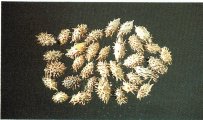Xanthium Fruit
http://www.100md.com
《e Natural Health Center》
 |
 |
 |
Herbs for Dispelling Wind and Cold
Xanthium Fruit
Latin:
Fructus Xanthii
Origin:
As the fruit of Xanthium sibiricum Patr., an annual herb, of the family Compositae, the herb is distributed all over China, picked and reaped in autumn, dried in the sun and used with hard thorns removed.
, http://www.100md.com
Properties:
Pungent and bitter in flavor, warm and slightly toxic in nature, it is related to the lung channel.
Functions:
Dispels wind, eliminates dampness, clears passages and alleviates pain.
Applications:
1. Used for rhinopharyngitis (inflammation of the nasopharynx) and headache with turbid nasal discharge and headache due to pathogenic wind-cold :
, 百拇医药
This herb clears away pathogens with its warm nature, dispels wind with its pungent taste, eliminates damp pathogens with its bitter taste and dry nature, clears passages and kills pain, so it is often used in combination with lily magnolia bud (Flos Magnoliae), dahurian angelic root (Radix Angelicae Dahuricae) and peppermint, e.g., Cangerzi San, for the treatment of rhinopharyngitis and headache with turbid nasal discharge, anosmia (absence of the sense of smell) and frequent turbid discharge. It can be used together with fangfeng (Radix Ledebouriellae), dahurian angelic root (Radix Angelicae Dahuricae), notopterygium root or rhizome (Rhizoma seu Radix Notopterygii), ligusticum (Rhizoma Ligustici), etc., for the treatment of those who suffer from affection caused by pathogenic wind-cold, aversion to cold and anhidrosis (absence of sweat) and headache with nasal obstruction.
, 百拇医药
2. Used for damp rheumatism and arthralgia:
As this herb dispels wind, eliminates dampness and removes obstruction in the channels to relieve pain, it can be used alone or together with large leaf gentian root (Radix Gentianae Macrophyllae), silkworm droppings, yam rhizome , etc., or soaked in wine, e.g., Shiguogong Yaojiu, for the treatment of rheumatism, arthralgia and spasms of the limbs.
In addition, this herb is used together with broom cypress fruit (Fructus Kochiae), ditlany root-bark (Cortex Dictamni Radicis), white puncture vine fruit (Fructus Tribuli), etc., for the treatment of rubella (German measles) and pruritus (itching). This herb is pulverized and made into oil-coated pills to treat scabies (contagious itch), tinea (fungal diseases of the skin) and leprosy by making use of its wind-dispelling and dampness-removing effects.
, 百拇医药
Dosage and Administration:
3-10 g.
Decoct the ingredients for drinking or include it in pills or powder.
Cautions on Use:
It should be avoided by those who suffer from headache due to blood deficiency. Any excessive administration is liable to cause poisoning.
Reference Materials:
, 百拇医药
'Shen Nong's Herbal Classic' :
"It is indicated for headache due to pathogenic wind-cold, rheumatism and general arthralgia, spasms and pains of the limbs and deadly injured muscles."
'Classified Major Drugs' :
"It is absolutely indispensable for the treatment of rhinopharyngitis with turbid nasal discharge because it enables fresh yang-qi to rise to the parietal area."
, 百拇医药
Toxic or Side Effects:
This herb has certain toxins, so an adult may be poisoned if more than 100 g. are taken. The symptoms of poisoning include headache, drowsiness, coma, general tonic spasms, accompanied by jaundice, hepatomegaly (enlargement of the liver), hepatic dysfunction with proteins or the appearance of albumin and red cells in the urine, while in serious cases, the patient may suffer failure of the respiratory, circulatory or renal functions and even die.
, http://www.100md.com
Modern Researches:
This herb contains xanthium glucoside, fatty oil, alkaloids, xanthanol, proteins and Vitamin C. The glucoside can reduce blood sugar remarkably. The xanthium decoction can arrest coughing; it may inhibit the heart to such an extent as to slow down the heart rate and weaken systole (the time at which ventricular contraction occurs); it has certain inhibitory effects on Staphylococcus aureus, streptococcus B and Diplococcus pneumoniae and it can resist fungi., http://www.100md.com